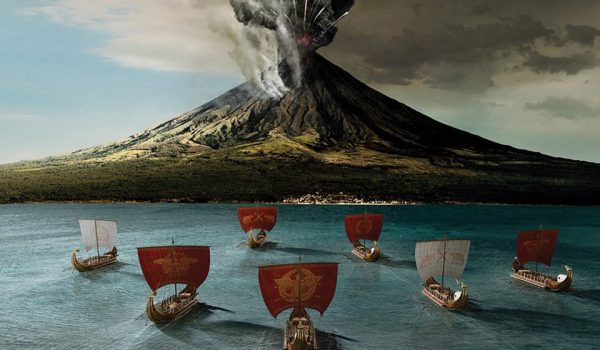Very few cultural treasures from prehistory and classical antiquity survive to a degree that enables us to look back today and experience everyday moments and events that took place many centuries ago. The Roman city of Pompeii on the Bay of Naples is one of them, and its ruins provide a rare and legendary snapshot of Roman daily life.
In AD 79 the volcano Vesuvius erupted and discharged explosive waves of volcanic ash and rock out over the Bay of Naples. The citizens of the towns of Pompeii and Herculaneum and the surrounding rural settlements became victims of the eruption, perceived as the end of the world. Snapshots of these flourishing towns and the victims, captured and frozen in terror as they fled from the scorching lava and ash, have – ever since the first excavations of the towns in 1592 and the scientific investigations initiated in the 18th century – attracted the world’s attention, and the ruins of the towns have since been visited by millions of tourists.
The Roman rescue operation
In Moesgaard Museum’s exhibition, visitors will be able to view exhibits from both Pompeii and Herculaneum that have never previously been shown outside Italy.
Research into the two towns has produced new information that has revised our understanding of the towns and the disaster, including when the volcanic eruption took place, as well as its nature and the actual sequence of events. Recent investigations of those who died in Pompeii have yielded new, ground-breaking details of the town’s citizens, while similar research on Herculaneum’s dead has resulted in a revised interpretation of a heroic rescue operation launched by commander-in-chief Pliny the Elder, stationed at the Roman Naval base of Misenum on the opposite side of the Bay of Naples.
When Vesuvius erupted, Pliny immediately set sail at the head of a fleet of warships with the aim of saving as many people as possible from the doomed towns. We know of his rescue operation from letters written by his nephew Pliny the Younger to the politician and historian Tacitus, in which he tells of his uncle’s heroic actions. Tacitus cites the letters in his work Historiae about the first centuries of the Roman Empire.
The letters are firsthand accounts of the disaster, the rescue attempt and the dramatic events, day and night, hour by hour, that engulfed the people of the Bay of Naples. It is also the earliest documented military rescue operation involving civilian victims of a natural catastrophe. The deployment of the fleet provides a vivid example of the navy’s function in the Roman Empire and the role of Pliny the Elder as naval commander.
The new special exhibition at Moesgaard Museum presents the towns of Pompeii and Herculaneum from a perspective focussing on the Roman Empire as ruler of the Adriatic and the Mediterranean. The expansion of the navy provided the foundation for the Roman lifestyle – a slave-based society, in which consumer goods, luxuries and forced labour flowed in enormous quantities across the Mediterranean and furnished the entire Roman Empire. Pompeii and Herculaneum benefitted hugely from their location in the place where trade flourished – until disaster struck.
One of the world’s greatest stories
The exhibition at Moesgaard Museum presents more than 250 objects on loan from seven Italian museums and cultural institutions. Visitors will be able to view reliefs and gravestones bearing inscriptions that provide vivid descriptions of and information about family relations, frescoes featuring maritime motifs, landscapes and everyday situations, military and maritime equipment and cargoes of commodities from distant destinations and the commercial harbour at Naples. There are also mosaics and marble statues, fountains and figures related to mythology and cult, together with jewellery and other luxury goods from the Romans’ high life before the cataclysm.
The exhibition also includes exhibits demonstrating the terrible consequences of the volcanic eruption, including casts of corpses from Pompeii and skeletons of the dead from Herculaneum.
”The Roman golden age in Pompeii and the eruption of Vesuvius are one of world history’s greatest stories. This exhibition is based on the latest research and presentation initiatives, and we are looking forward very much to sharing with visitors the latest information on the Roman Empire and fresh insights into the consequences of the enormous natural catastrophe the volcanic eruption proved to be,” says the director of Moesgaard Museum, Mads Kähler Holst.
The special exhibition on Pompeii and Herculaneum at Moesgaard Museum is supported by Augustinus Fonden, Aage og Johanne Louis-Hansens Fond, Spar Nord Fonden, Knud Højgaards Fond and KrogagerFonden, and continues until 10th May 2020.
The special exhibition on Pompeii and Herculaneum is produced by Moesgaard Museum with loans from the following Italian museums and cultural institutions:
- Herculaneum, Parco Archeologico di Ercolano
- Naples, Museo Archeologico Nazionale di Napoli
- Naples, Parco Archeologico dei Campi Flegrei – Museo Archeologico dei Campi Flegrei nel Castello di Baia
- Naples, Soprintendenza Archeologia Belle Arti e Paesaggio per il comune di Napoli
- Palermo, Soprintendenza del Mare
- Pompeii, Parco Archeologico di Pompei


